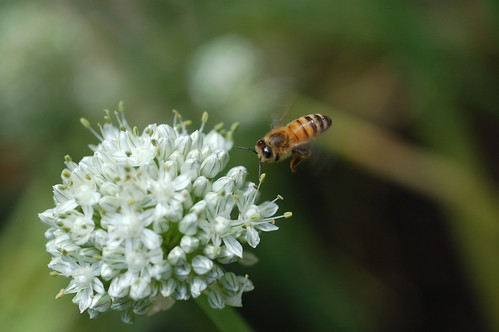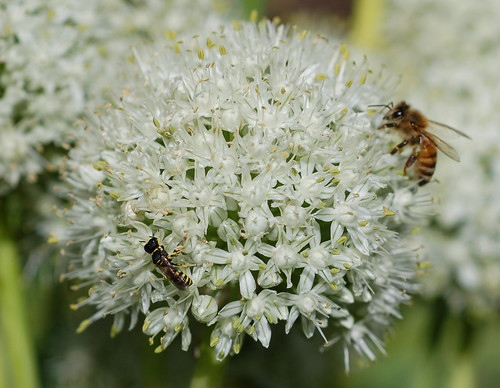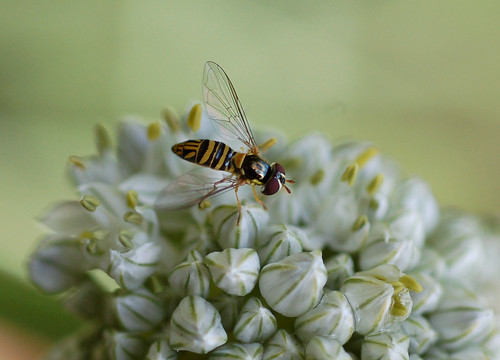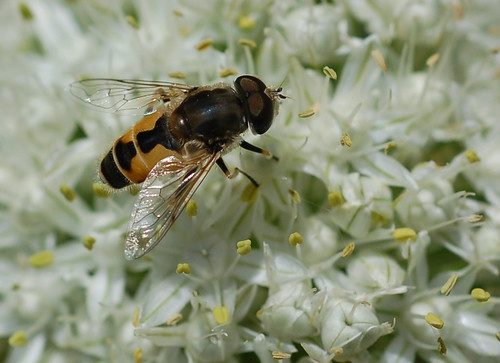Bees and Bee Mimics
...

Our crop of shallots are blooming, and the bees seem very pleased. I thought I'd harvest a bunch of these, but the flowers were providing food for so many creatures, that I didn't have the heart to remove them from the garden just yet. I'll wait until the flowers die back a bit.

It's interesting to see how many insects share a bee-like form. Also fascinating to observe the variations in size and coloration. This tiny wasp could be mistaken for a honeybee, if an actual honeybee weren't working the same flower-ball. The shallot flowers are no more than an inch and a half in diameter.

Look how tiny this little fellow is, compared to the individual flowers of the shallot. I'm going to be lazy, and not look up the scientific names of all of these insects. I'm just going to enjoy their appearances, and not worry about taxonomy. This dude is, I believe, some kind of fly. I tend to look at insects eyes, and decide if they are flies or bees. I could be dead wrong about this, of course. I think that the antennae also offer some clues to the fly-ness or bee-ness of these creatures. Bees, I think, have longer antennae.

This is a wee native bee. You can see her two larger eyes on the sides of her head, and her three smaller eyes, just behind her antennae. She and the honeybee are the only fuzzy looking insects. You can see the flower pollen on her furry little legs.

Here's another fly. We see a lot of these, in our little garden. They are the largest of the bee mimics that visit our yard.
I'm not sure that most people slow down enough to notice these creatures. I say this a lot, but take a moment and look around. You might be delighted by what you see.

Our crop of shallots are blooming, and the bees seem very pleased. I thought I'd harvest a bunch of these, but the flowers were providing food for so many creatures, that I didn't have the heart to remove them from the garden just yet. I'll wait until the flowers die back a bit.

It's interesting to see how many insects share a bee-like form. Also fascinating to observe the variations in size and coloration. This tiny wasp could be mistaken for a honeybee, if an actual honeybee weren't working the same flower-ball. The shallot flowers are no more than an inch and a half in diameter.

Look how tiny this little fellow is, compared to the individual flowers of the shallot. I'm going to be lazy, and not look up the scientific names of all of these insects. I'm just going to enjoy their appearances, and not worry about taxonomy. This dude is, I believe, some kind of fly. I tend to look at insects eyes, and decide if they are flies or bees. I could be dead wrong about this, of course. I think that the antennae also offer some clues to the fly-ness or bee-ness of these creatures. Bees, I think, have longer antennae.

This is a wee native bee. You can see her two larger eyes on the sides of her head, and her three smaller eyes, just behind her antennae. She and the honeybee are the only fuzzy looking insects. You can see the flower pollen on her furry little legs.

Here's another fly. We see a lot of these, in our little garden. They are the largest of the bee mimics that visit our yard.
I'm not sure that most people slow down enough to notice these creatures. I say this a lot, but take a moment and look around. You might be delighted by what you see.

Comments
Thanks for sharing, as always!
-Di A/Q
HIxson TN
LB
I have to laugh at the gender classifications you've assigned to the bees and flies. I totally do the same thing with no rhyme or reason.
And golly gee, those photos are out of control amazing!
Di: I'm shooting with an "older" Nikon digital single lens reflex camera, the D50. I think all those photos were taken with a macro lens.
CrescentJoy -- if you come over, you'll feel so smug about your own home renovations! Seriously, though, want to pick plums?
Christine -- you too! Wanna pick plums. They're just super-normal Santa Rosa plums, but they sure are tasty! As for the gender, well, all hard working bees are female, and all flies are male. Who doesn't know that?
Also, "Do I have California Insects?" That sounds like a set up for a Groucho Marx joke.